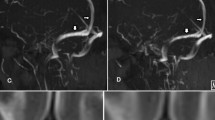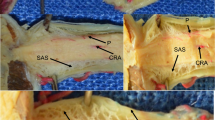Summary
In 27 young healthy guinea pigs the cerebrospinal fluid was stained with rhodamine by suboccipital punction. After removing the neck muscles a small piece of plastic tape was glued to the atlanto-occipital membrane with Histoacryl. When the plastic foil and the membrane are punctured by a fine needle, the canal closes by itself through the elasticity of the tape. Glas capillaries with an outer diameter of less then 0.1 mm were filled with 0.1 μl of a 2% rhodamine solution. After freeze drying, the tip contains 2 μg of the dye. The capillary is then pushed through the preformed canal into the cerebrospinal fluid by the aid of a micromanipulator. 0.1 μl of the CSF is allowed to enter the capillary to dissolve the dye and is then restored into the cerebellomedular cistern.
The advantage of this technique is that CSF is used as the solvent. This procedure is nearly pressure free. Moreover the system remains closed because the elasticity of the plastic tape keeps a tight contact to the capillary and the CSF cannot escape on the sides of the capillary.
At different time intervals after the application, the distribution of the dye is stopped by quickly deep freezing the whole head with liquid air. The head is then severed, mounted on the table of a cryotome and cut in 20 μm steps. At certain levels the mounted object is fotographed under normal and UV-light with aid of an operating microscope. The position of the rhodamine can bee seen by the yellow fluorescense of the rhodaminelipid complex which forms in the cell membranes.
The distribution of the dye was studied in twelf living and six dead animals to differentiate between active flow and passive diffusion. In the living animals the rhodamine spreads in the subarachnoidal space in a frontocranial direction. It reached the frontal part of the brain after 20 min and did not enter the cochlear aqueduct (Figs. 2 and 3). In the dead animals the distribution of the dye was much slower and the dye entered the aqueduct after 30 min and reached the cochlea after 1 h.
These results support the conclusion that in the guinea pig there is a flow of cerebrospinal fluid from the cerebellomedular cistern to the frontal parts of the brain. Even when it passes the funnel shaped opening of the perilymphatic duct it does not enter it.
Earlier investigators reported the finding that the cerebrospinal fluid enters the cochlea. This depends on the relative big volumes which were used. The fluid amounts which have been applied to the CSF addionally or by exchange to withdrawn CSF are 500–2000 times bigger than the volume we used. Our own results with big volumes (0.05–0.1 ml) are the same as other investigators have shown.
Because the method we used is nearly pressure free and keeps the fluid spaces closed throughout the whole experiment, we can support the statement, that perilymph is produced in the cochlea and does not derive from the cerebrospinal fluid.
Similar content being viewed by others
Literatur
Altmann, F., Waltner, J. G.: The physiology of the perilymphatic fluid. Trans. Amer. laryng. rhin. otol. Soc. 48, 361–367 (1947)
Altmann, F., Waltner, J. G.: New investigations on the physiology of the Labyrinthine fluids. Laryngoscope (St. Louis) 60, 727–739 (1950)
Angelborg, C.: Distribution of macromolecular tracer particles (Thorotrast) in the cochlea. An electron microscopic study in guinea pig. Acta oto-laryng. (Stockh.) Suppl. 319, 19–41 (1973)
Anson, B. J., Donaldson, J. A., Warpeha, R. L. et al.: A critical appraisal of the anatomy of the perilymphatic system in man. Laryngoscope (St. Louis) 74, 945–966 (1964)
Arnold, W.: Zur Frage der Produktion und Resorption der Perilymphe (Lymphabfluß des Innenohrs). Z. Laryng. Rhinol. 53, 774–790 (1974)
Arnold, W., Ilberg, C. v.: Verbindungswege zwischen Liquor und Perilymphraum. Arch. klin. exp. Ohr.-, Nas.- u. Kehlk.-Heilk. 198, 247–261 (1971)
Arnold, W., Ritter, R., Nitze, H. R., Wagner, W.: Morphologische und kinetische Studien zum Lymphabfluß des Liquor cerebrospinalis. Arch. klin. exp. Ohr.-, Nas.- u. Kehlk.-Heilk. 202, 389–394 (1972)
Arnvig, J.: Relation of the ear to the subarachnoid space and absorption of the labyrinthine fluid. Acta oto-laryng. (Stockh.) Suppl. 96, 1–73 (1951)
Cotugno, G.: De aquaductibus auris humani internae. Wien 1774
du Verney, J. G.: Tractatus de organo auditus. Nürnberg 1684
Giebel, W.: Proteins and amino acids in inner ear fluids. In: Otorhinolaryngology, Proceedings of the X. World Congress (Arslan, M., Ricci, V., eds.). Excerpta med. ICS 337, 790–793 (1973)
Giebel, W.: Quantitative Bestimmung von Aminosäuren in Endolymphe, Perilymphe, Liquor und Serum. Vortrag 10. intern. Symposion für Innenohrbiologie, Graz 1973
Giebel, W., Wespi, H.: Serumproteine und Aminosäuren in menschlicher Perilymphe. Arch. klin. exp. Ohr.-, Nas.- u. Kehlk.- Heilk. 205, 182–186 (1973)
Giebel, W., Kaupp, H., Kommoss, J.: Zur Ausbreitung löslicher Substanzen nach Applikation in Perilymphe und Liquor. Arch. Oto-Rhino-Laryng. 213, 447–448 (1976)
Gisselson, L.: The Passage of fluorescein sodium to the labyrinthine fluids. Acta oto-laryng. (Stockh.) 37, 268–275 (1949)
Graf, K., Poretti, G.: Die Entstehung der Perilymphe. Pract. oto-rhino-laryng. (Basel) 12, 351–365 (1950)
Hughes, D. E., Chou, J. T. Y.: The origin of the perilymph of the inner ear. Life Sciences 2, 107–111 (1963)
Jako, G. F. L., Weille, F. L., Palmer, P. E., Irwim, J. W.: An experimental study of the dynamic circulation of the labyrinthine fluids. Ann. Otol. (St. Louis) 68, 733–739 (1959)
Jampolsky, L. N.: Über den morphologischen Zusammenhang des Subarachnoidalraumes mit dem Labyrinth. Mschr. Ohrenheilk. 69, 23–34 (1935)
Karbowski, B.: Vergleichende anatomische Studien über den Aquaeductus cochleae und über seine Beziehung zum Subarachnoidalraum des Gehirns. Mschr. Ohrenheilk. 64, 687–715 (1930)
Karlefors, J.: Die Hirnhauträume des Kleinhirns, die Verbindungen des 4. Ventrikels mit den Subarachnoidalräumen und der Aquaeductus cochleae beim Menschen. Acta oto-laryng. (Stockh.) Suppl. 4, 1–184 (1924)
Kimura, R. S., Schuknecht, H. F., Ota, C. Y.: Blockage of the cochlear aquaeduct. Acta oto-laryng. (Stockh.) 77, 1–12 (1974)
Kley, E.: Zur Herkunft der Perilymphe. Z. Laryng. Rhinol. 30, 486–502 (1951)
Kobrak, F.: Labyrinthliquor; Theoretische und angewandte Physiologie des Labyrinthliquors. Arch. Ohr.-, Nas.- u. Kehlk.-Heilk. 156, 30–112 (1949)
Lempert, J., Meltzer, P. E., Lawrence, H., Wever, E. G., Rambo, J. T. H.: Structure and function of the cochlear aquaeduct. Arch. Otolaryng. 55, 134–145 (1952)
Meurmann, Y.: Zur Anatomie und Physiologie des Aquaeductus cochleae; Vorläufige Mitteilung. Z. Laryng. Rhinol. 17, 401–409 (1929)
Meurmann, Y.: Zur Anatomie des Aquaeductus cochleae nebst einigen Bemerkungen über dessen Physiologie. Acta Soc. Med. „Duodecim”, Ser. B. 13, 1 (1931)
Meyer, M.: Über die Durchlässigkeit des Endolymphschlauches für Flüssigkeiten. Z. Laryng. Rhinol. 30, 455–466 (1951)
Müsebeck, K.: Die perivasculären Lymphspalten des Innenohrs. Arch. Ohr.-, Nas.- u. Kehlk.-Heilk. 184, 560–570 (1965)
Neiger, M.: Zur Morphologie und Physiologie des Aquaeductus cochleae. Habilitationsschrift 1968. Fortschr. Hals-Nas.-Ohrenheilk. 15, 113–226 (1968)
Nomura, Y.: Capillary permeability of the cochlea. Ann. Otol. (St. Louis) 70, 81–101 (1961)
Oršulaková, A.: Experimentelle Untersuchungen über die passiven Austauschvorgänge zwischen Liquor cerebrospinalis, Blut und Innenohrflüssigkeiten (beim Meerschweinchen). Inaugural-Dissertation, Düsseldorf 1975
Palva, R., Dammert, K.: Human cochlear aquaeduct. Acta oto-laryng. (Stockh.) Suppl. 246, 1–58 (1971)
Rauch, S.: Biochemie des Hörorganes. Stuttgart: Thieme 1964
Retzius, G.: Das Gehörorgan der Wirbeltiere. Stockholm: Samson und Wallin 1884
Ritter, F. N., Lawrence, M.: A histological and experimental study of cochlear aquaeduct patency in the adult human. Laryngoscope (St. Louis) 75, 1224–1233 (1965)
Sando, I., Wood, R. P., Masuda, Y., Hemenway, W. G.: Perilymphatic communication routes in guinea pig cochlea. Ann. Otol. (St. Louis) 80, 826–834 (1971)
Schreiner, L.: Untersuchungen mit markierten Stoffen zur Durchgängigkeit des Aquaeductus cochleae. Arch. Ohr.-, Nas.- u. Kehlk.-Heilk. 182, 587–590 (1963)
Schreiner, L.: Experimentelle Untersuchungen über die Bildungsstätte und den Stoffaustausch der Perilymphe. Acta oto-laryng. (Stockh.) Suppl. 212, 1–56 (1966)
Schnieder, E. A.: A contribution to the physiology of the perilymph; Part I; The origins of perilymph. Ann. Otol. (St. Louis) 83, 76–83 (1974)
Schindler, K.: Perilymphe als Ultrafiltrat des Serums. Arch. Ohr.-, Nas.- u. Kehlk.-Heilk. 185, 586–592 (1965)
Schuknecht, H. F., Seifi, A. E.: Experimental observations on the fluid physiology of the inner ear. Ann. Otol. (St. Louis) 72, 687–712 (1963)
Silverstein, H.: Cochlear aquaeduct obstruction changes in perilymph biochemistry. Ann. Otol. (St. Louis) 78, 532–541 (1969)
Svane-Knudsen, W. V.: Resorption of the cerebrospinal fluid in guinea pig. Acta oto-laryng. (Stockh.) 49, 240–251 (1958)
Waltner, J. G.: Barrier membrane of the cochlear aquaeduct. Histologic studies on the patency of the cochlear aquaeduct. Arch. Otolaryng. 47, 656–669 (1948)
Waltner, J. G.: The chemical composition of perilymph in cats. Laryngoscope (St. Louis) 64, 617–622 (1954)
Wittmaak, K.: Betrachtungen über die Erkrankungsprozesse des inneren Ohres auf der Grundlage der Tonuslehre. Arch. Ohr.-, Nas.- u. Kehlk.-Heilk. 141, 25–42 (1942)
Author information
Authors and Affiliations
Additional information
Mit Unterstützung durch die Deutsche Forschungsgemeinschaft
Auszugsweise Veröffentlichung der Dissertation von Johannes Kommoss
Rights and permissions
About this article
Cite this article
Kommoss, J., Giebel, W. Die Ausbreitung löslicher Substanzen nach Applikation in die Cisterna cerebellomedularis. Arch Otorhinolaryngol 221, 67–76 (1978). https://doi.org/10.1007/BF00456385
Received:
Issue Date:
DOI: https://doi.org/10.1007/BF00456385




